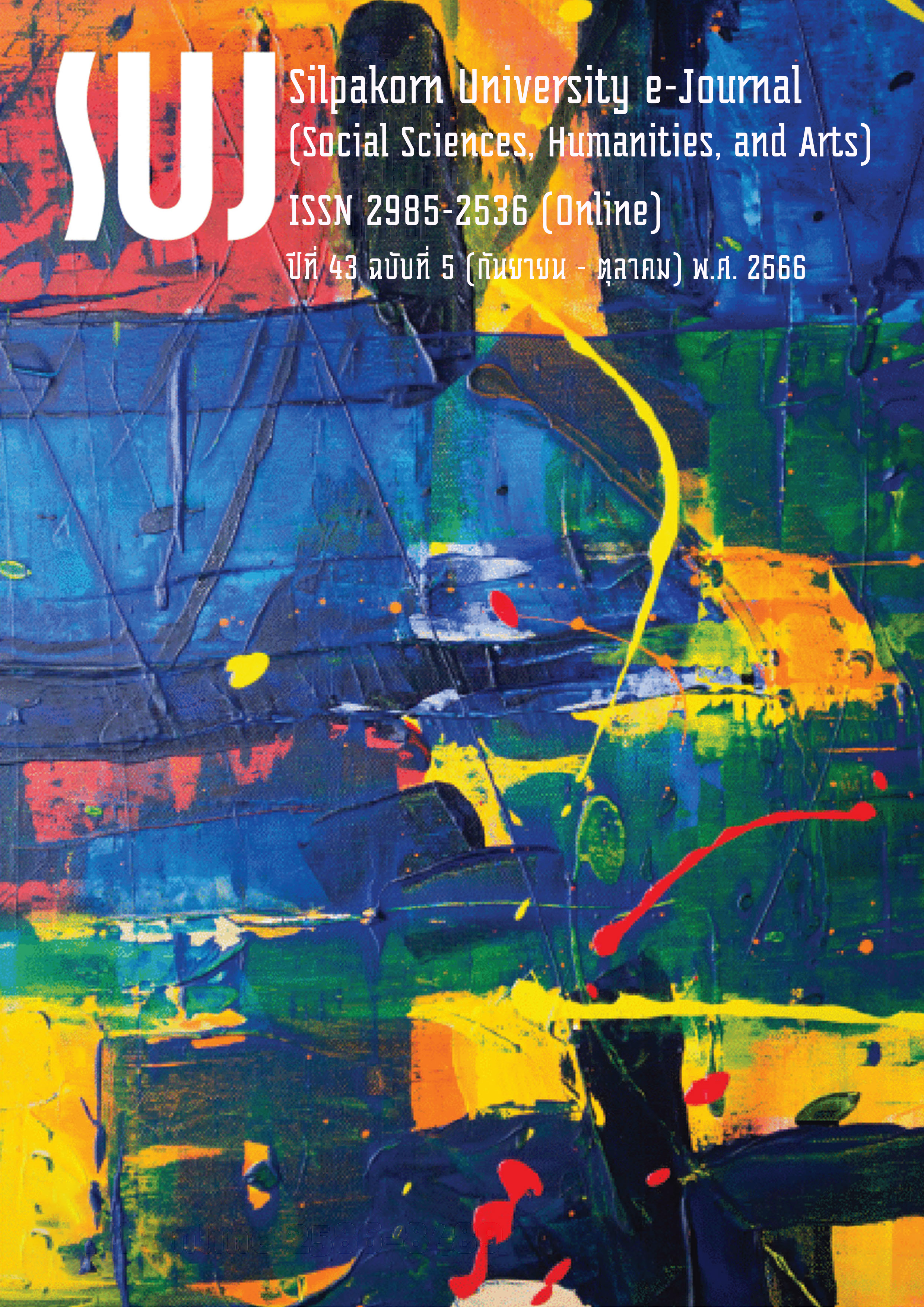การพัฒนากระบวนการเรียนรู้ของผู้ที่มีความบกพร่องทางการได้ยิน ด้วยการสร้างสรรค์ต่อยอดวัสดุจากดิน ไม้ และผ้า สู่หัตถกรรมเชิงพาณิชย์ (The development of learning processes for individuals with hearing impairments through creative utilization of clay, wood, and fabric materials in commercial craftwork)
Main Article Content
บทคัดย่อ
โครงการวิจัยนี้มีวัตถุประสงค์ 1) เพื่อพัฒนารูปแบบการจัดการกระบวนการเรียนรู้ของผู้ที่มีความบกพร่องทางการได้ยิน ด้วยการสร้างสรรค์ต่อยอดวัสดุจากดิน ไม้ และผ้า สู่งานหัตถกรรมเชิงพาณิชย์ 2) เพื่อสร้างองค์ความรู้เพิ่มพูนสมรรถนะทักษะในการสร้างสรรค์สำหรับผู้ที่มีความบกพร่องทางการได้ยินให้มีประสิทธิภาพและประสิทธิผลเหมาะสมกับบริบทสังคมปัจจุบัน และ 3) ยกระดับรูปแบบของการศึกษาเพื่อส่งเสริมให้ผู้ที่มีความบกพร่องทางการได้ยินสามารถนำความรู้และทักษะไปประกอบอาชีพ เพิ่มความสามารถในการถูกจ้างงานในอุตสาหกรรมที่เกี่ยวข้อง รูปแบบการวิจัยเป็นการวิจัยเชิงคุณภาพ โดยใช้วิธีดำเนินการวิจัยเชิงปฏิบัติการแบบมีส่วนร่วม ใช้แนวคิดการจัดการศึกษาสำหรับผู้ที่มีความบกพร่องทางการได้ยินและทฤษฎีการคิดเชิงออกแบบเป็นกรอบการวิจัย พื้นที่วิจัย คือ วิทยาลัยราชสุดา มหาวิทยาลัยมหิดล โดยรูปแบบการสืบค้นจะมุ่งเน้นไปที่การศึกษากลุ่มนักศึกษาผู้มีความบกพร่องทางการได้ยิน จำนวน 10 คน ผลการวิจัยพบว่า วิธีสอนและถ่ายทอดทักษะด้วยกระบวนการบันทึลำดับขั้นตอนอย่างชัดเจนด้วยแผนภาพวัสดุที่ใช้จริง กระตุ้นการเรียนรู้ให้น่าสนใจด้วยรสนิยมส่วนบุคคล สีและลวดลาย การจัดพื้นที่ให้เหมาะสมในการปฏิบัติงาน เพื่อให้ผู้เรียนที่มีความบกพร่องทางการได้ยินได้ศึกษาทบทวนแล้วสามารถทำตามได้ตามลำดับด้วยตนเองเป็นผลสำเร็จ มีสัดส่วนในเกณฑ์ดีมากและดี รวมกันคิดเป็นสัดส่วนไม่น้อยกว่าร้อยละ 80 จากทั้ง 3 วัสดุ ซึ่งเป็นแนวโน้มของความเป็นไปได้ในการฝึกกระบวนการด้านความคิดสร้างสรรค์ เพื่อต่อยอดวัสดุดิน ไม้ และผ้า สู่การออกแบบผลงานหัตถกรรมเชิงพาณิชย์ให้มีอัตลักษณ์เฉพาะตนอย่างชัดเจน สามารถนำไปประยุกต์ใช้ในการประกอบอาชีพได้ในอนาคตอย่างยั่งยืน
The aims of this research project are: 1) to develop a learning process management model for individuals with hearing impairments by creatively transforming materials such as clay, wood, and fabric into commercial handicrafts; 2) to enhance knowledge and skills in creative craftsmanship for individuals with hearing impairments, making them effective and suitable for the current social context; and 3) to elevate the education model to empower individuals with hearing impairments to apply their knowledge and skills in relevant industries, increasing their employability. This research adopts a qualitative research approach with participatory action research methods, utilizing educational management concepts for individuals with hearing impairments and design thinking as the framework. The research takes place at Ratchasuda College, Mahidol University, focusing on studying a group of 10 students with hearing impairments. The research findings reveal that effective teaching methods and skills transfer involve clearly documented step-by-step processes using visual diagrams of the actual materials. Stimulating learning involves personal preferences in taste, colors, and patterns. Additionally, providing suitable working spaces encourages self-directed learning, resulting in successful outcomes. The overall satisfaction rating of the research criteria achieved a proportion of no less than 80% for the three materials, indicating a high level of success. This suggests a potential direction for fostering creative thinking processes, extending from clay, wood, and fabric materials to designing commercially distinctive handicrafts. These creations can be applied in future professions, enhancing sustained employability.
Article Details

This work is licensed under a Creative Commons Attribution-NonCommercial-NoDerivatives 4.0 International License.
References
Chansongsaeng, Weerasak. (2006). Sound from Silence World : Hands Convey Language, Eyes Convey Emotions (เสียงจากโลกเงียบ : มือสื่อภาษาตาสื่อใจ). Bangkok: 3 Lada Ltd. Partnership.
Education Management for Persons with Disabilities Act B.E. 2551 (2008) (พระราชบัญญัติการจัดการศึกษาสำหรับคนพิการ พ.ศ. 2551). (2008, February 5). Royal Thai Government Gazette (No. 125 Chapter 28 a, pp. 1-13). [Online]. Retrieved April 19, 2022 from https://shorturl.asia/AY54b
Kongpreephan, Duangnet. (1998). A Comparison of Procedural Content Learning Achievement and Retention of Hearing-Impaired Students Learning from Computer Assisted Instruction Lessons with Different Strategic Groups of Animation (การเปรียบเทียบผลสัมฤทธิ์ทางการเรียนและความคงทนในการจำเนื้อหาที่เป็นกระบวนการของนักเรียนที่มีความบกพร่องทางการได้ยินที่เรียนด้วยบทเรียนคอมพิวเตอร์ช่วยสอนที่มีกลยุทธ์การนำเสนอภาพเคลื่อนไหวต่างกัน). Master’s dissertation, Chulalongkorn University, Bangkok, Thailand.
Myklebust, H. R. (1964). The Psychology of Deafness: Sensory Deprivation, Learning, and Adjustment (2nd ed.). NY: Grune and Stratton.
National Education Act B.E. 2542 (1999), Amendments (Second National Education Act) B.E. 2545 (2002) and (Third National Education Act) B.E. 2553 (2010) (พระราชบัญญัติการศึกษาแห่งชาติ พ.ศ. 2542 แก้ไขเพิ่มเติม (ฉบับที่ 2) พ.ศ. 2545 และ (ฉบับที่ 3) พ.ศ. 2553). [Online]. Retrieved April 19, 2022 from https://drive.google.com/file/d/1io9ioK38P_pjWtZBiblus409rEdC24aj/view?pli=1
Niyomtham, Sriya. (1995). Hearing Impaired: Psychological, Educational, and Social Implications (ความบกพร่องทางการได้ยิน: ผลกระทบทางจิตวิทยา การศึกษาและสังคม). Bangkok: Ramthai Press.
Office of the National Economic and Social Development Board, Office of the Prime Minister. (2017). The Twelfth National Economic and Social Development Plan (2017-2021) (แผนพัฒนาเศรษฐกิจและสังคมแห่งชาติ ฉบับที่ 12 พ.ศ. 2560-2564). [Online]. Retrieved March 11, 2021 from https://www.nesdc.go.th/main.php?filename=develop_issue
Srion, Jitprapa, & Thettim, Jenjira. (2005). A study of holiday time spending behavior of deaf of Bangkok (การศึกษาพฤติกรรมการใช้เวลาวันหยุดของคนหูหนวกในกรุงเทพมหานคร). Journal of Ratchasuda College for Research and Development for Persons with Disabilities, 1(1): 1-15.
Stanford d.school. (2013). Welcome to the Virtual Crash Course in Design Thinking. [Online]. Retrieved May 20, 2021 from http://www.dennis-oswald.de/BLOG/?p=584*
Suwannarat, Kamphon. (2010). The Driving Force of the Silent World in Siam (พลังขับเคลื่อนแห่งโลกเงียบในสยาม). Nonthaburi: Yim Su Printing House of the Thai Disabled Foundation.

